
TNU Journal of Science and Technology
229(06): 187 - 194
http://jst.tnu.edu.vn 187 Email: jst@tnu.edu.vn
TREATMENT OF MALACHITE GREEN IN AQUEOUS SOLUTION
USING CHITOSAN/PECTIN/SiO2 COMPOSITE
Tran Nguyen Phuong Lan1*, Nguyen Le Hue Tran1, Ly Kim Phung1, Le Duc Duy1,
Nguyen Hong Nam2, Tran Thi Minh Thu3, Nguyen Trong Hong Phuc1, Nguyen Minh Nhut1
1Can Tho University, 2University of Science and Technology of Ha Noi – VAST, 3Can Tho University of Technology
ARTICLE INFO
ABSTRACT
Received:
28/3/2024
The synthesis process of chitosan/pectin/SiO2 composite (CPS) was
performed under the following conditions: mass ratio of chitosan/pectin
(CP):SiO2=1:1.5 (g/g), mixing time of 0.5 h at room temperature. In this
work, pectin was extracted from pomelo peel while rice husk ash was used
for silica recovery. The obtained CPS were characterized by X-ray diffraction
(XRD), Fourier transform infrared spectroscopy (FTIR), and Field emission
scanning electron microscopy (FE-SEM). The typical functional groups of
CP and SiO2 are fully appeared in CPS. Malachite green (MG) was used in
this work to evaluate the dye removal possibility of CPS at pH 7, a MG
concentration of 60 mg/L, a MG dosage of 1 g/L, and an adsorption time of
30 min. The MG adsorption capacity and adsorption efficiency are 61.3 mg/g
and 75.93%, respectively. The MG adsorption process is consistent with the
Langmuir and Sips isotherm adsorption models, meaning the adsorption takes
place homogeneously, monolayer, independently and is physical adsorption.
Besides, the kinetics of the MG adsorption process follows the pseudo 2nd
order kinetic model. As a result, the CPS is a potential composite for treating
MG dye in an aqueous solution.
Revised:
23/5/2024
Published:
24/5/2024
KEYWORDS
Chitosan/pectin/SiO2
Rice husk ash
Pomelo peel
Malachite green
Adsorption
XỬ LÝ MALACHITE GREEN TRONG NƯỚC BẰNG VẬT LIỆU COMPOSITE
CHITOSAN/PECTIN/SiO2
Trần Nguyễn Phương Lan1*, Nguyễn Lê Huế Trân1, Lý Kim Phụng1, Lê Đức Duy1,
Nguyễn Hồng Nam2, Trần Thị Minh Thư3, Nguyễn Trọng Hồng Phúc1, Nguyễn Minh Nhựt1
1Trường Đại học Cần Thơ; 2Trường Đại học Khoa học và Công nghệ Hà Nội - Viện Hàn Lâm Khoa học và Công nghệ
Việt Nam, 3Trường Đại học Kỹ thuật Công nghệ Cần Thơ
THÔNG TIN BÀI BÁO
TÓM TẮT
Ngày nhận bài:
28/3/2024
Nghiên cứu này trình bày quy trình tổng hợp composite chitosan/pectin/SiO2
(CPS) ở nhiệt độ phòng, với tỷ lệ khối lượng chitosan/pectin (CP):SiO2 =
1:1.5 (g/g), thời gian khuấy trộn 0,5 giờ. Trong nghiên cứu này, pectin được
trích ly từ vỏ bưởi và tro trấu được sử dụng để thu hồi SiO2. Các CPS được
đánh giá đặc trưng bằng phương pháp nhiễu xạ tia X (XRD), phổ biến đổi
hồng ngoại Fourier (FTIR), và kính hiển vi quét điện tử (SEM). Các nhóm
chức đặc trưng của pectin, chitosan và SiO2 đều xuất hiện đầy đủ trong thành
phần của CPS. Thí nghiệm hấp phụ xử lý malachite green (MG) được thực
hiện ở pH 7, nồng độ MG 60 mg/L, khối lượng CPS 1 g/L, thời gian hấp phụ
30 phút. Dung lượng và hiệu suất hấp phụ MG lần lượt là 61,3 mg/g và
75,93%. Quá trình hấp phụ MG phù hợp với mô hình hấp phụ đẳng nhiệt
Langmuir và Sips, sự hấp phụ diễn ra đồng nhất, đơn lớp, độc lập và là hấp
phụ vật lý. Ngoài ra, động học của quá trình hấp phụ tuân theo mô hình động
học giả kiến bậc hai. Vì vậy, CPS là vật liệu composite tiềm năng được ứng
dụng để xử lý thuốc nhuộm MG trong môi trường nước.
Ngày hoàn thiện:
23/5/2024
Ngày đăng:
24/5/2024
TỪ KHÓA
Chitosan/pectin/SiO2
Tro trấu
Vỏ bưởi
Malachite green
Hấp phụ
DOI: https://doi.org/10.34238/tnu-jst.9979
* Corresponding author. Email: tnplan@ctu.edu.vn

TNU Journal of Science and Technology
229(06): 187 - 194
http://jst.tnu.edu.vn 188 Email: jst@tnu.edu.vn
1. Introduction
Various kinds of dye and pigment are extensively developed globally because of their wide
applications. Typically, more than 0.7 million ton of synthesized dyes are produced annually,
about 200,000 tons of dye are released to environment [1]. Malachite green (MG), a cation
organic dye can cause several harmful diseases such as jaundice, blood clots and gastrointestinal
irritation [2]. In Vietnam, rice husk, generated through rice producing, is mainly used as an
energy source via burning. Its by-product is rice husk ash (RHA), which is a rich source of SiO2
[3]. Chitosan, a product of chitin deacetylation, is found in the shells of shrimp, crap, and etc. and
applied in many fields such as biotechnology, agriculture, cosmetic, food processing, and
wastewater treatment [4]. Pectin, a group of polysaccharides in the plant cell wall, is composed of
covalent bonding of D-galacturonic acid units. The mesocarp of pomelo peel is accounted for
about 30 wt.% of fruit, which is used as the feedstock for pectin recovery. Chitosan/pectin (CP)
composite with pectin originated from pomelo peel and application for methylene blue removal
was investigated with the adsorption efficiency and capacity of 63.54% and 6.345 mg/g,
respectively at a weight ratio of C and P of 1:9 [5]. Additionally, a composite of chitosan/SiO2
was used for adsorbing heavy metals like Cu(II), Cr(VI) and Pb(II) [4]. Using nano chitosan/SiO2
for the CO2 adsorption reported a maximum adsorption capacity of 4.39 mmol/g [6]. The
adsorption mechanism was demonstrated by using the experiment between carbon micro-
particles and turmeric solution [7]. The maximum adsorption efficiency of MG between 95.6%
and 98.3% by using Sargassum crassifolium was performed at the optimal condition: pH 8.0, 25
°C, biomass dose of 2.0 g during 150 min [8]. This study aimed to synthesize a composite (CPS)
including CP and SiO2 and evaluate its adsorption capacity towards MG cation dye. To improve
the efficiency of MG adsorption, the CPS synthesis parameters such as the weight ratio of CP and
SiO2, stirring temperature and time were investigated. The possible MG adsorption mechanism of
CPS was predicted using the adsorption isotherm models (Langmuir, Freundlich and Sips) and
pseudo first and second order adsorption kinetic models.
2. Materials and Methods
RHA used in this study was collected from Tra Noc Industrial Park, Can Tho city. Sodium
hydroxide (96%), hydrochloric acid (36-38%), citric acid (99.5%), acetic acid (99.5%), ethanol
(96%), potassium chloride (99%), and malachite green (C23H25ClN2) were provided by from
Xilong (China). Chitosan (medium molecular weight, with a degree of deacetylation of 87%).
Pomelo peels were collected at a local market in Can Tho city.
2.1. Synthesis of CPS composite
The CP synthesis procedure was adopted from the previous study [5]. The pectin extraction
was carried out with a pomelo peel:citric acid (0.14 M) amount of 1:20 g/mL at 95oC for 60 min.
The extraction yield was 18%. Moreover, the CP composite was generated at a weight ratio of
chitosan to pectin of 9:1 at room temperature (RT). Chitosan solution was prepared by dissolving
0.1 g of chitosan in 10 mL 5% acetic acid solution, while 0.9 g of pectin was put into 90 g
deionized water to obtain the pectin solution [5]. SiO2 was extracted using RHA and 5 M NaOH
at a ratio of 1:10 g/mL for 3 h at 90oC [9]. The suspension was then filtrated to remove solid, the
aqueous mainly contains sodium silicate. After that, 3 M HCl solution was added dropwise to
previous solution at a ratio of 9:20 v/v at RT until white precipitate appeared. SiO2 powder was
obtained by filtration and washing of suspension to neutral pH and dried at 60oC. The CPS
synthesis was processed as follows: Slowly added a certain weight of SiO2 into the pectin
solution at RT and stirred at 500 rpm for 1 h to obtain solution 1. Chitosan solution was added to
the above solution. The obtained solution was then neutralized using 1 M NaOH, CPS was
collected after filtration, washing and drying at 60oC. This work investigated synthesis

TNU Journal of Science and Technology
229(06): 187 - 194
http://jst.tnu.edu.vn 189 Email: jst@tnu.edu.vn
parameters including the weight ratio of CP:SiO2 = 1:0.5 – 1:3 (g/g), stirring temperature from
RT to 90oC, and time from 0.25 – 4 h.
2.2. Characterization of CPS composite
CPS were characterized using X-ray diffraction (XRD, Empyrean, PANalytical), Fourier
transform infrared spectroscopy (FTIR, MIR/NIR Frontier, PerkinElmer), and Field emission
scanning electron microscopy (FE-SEM, Hitachi S-4800).
2.3. Evaluation of MG removal using CPS composite
Point of zero charge of CPS (pHpzc) was determined via the difference of pH values in which
adsorption of H+ and OH- ions on the CPS surface in 24 h. Briefly, 0.1 g of CPS and 25 mL of
0.1 M KCl were prepared. The pH value of each solution was adjusted from 3 to 12 using 0.1 M
KOH or 0.1 M HCl. All experiments in this work were triplicated. The MG adsorption process
was performed as follows: adsorbent dose (0.5 - 4.0 g/L), MG concentration (10 - 100 mg/L), and
adsorption time (15-1440 min). The MG concentrations before and after adsorption were
determined using an Evolution 60S UV-Visible Spectrophotometer (Thermo, USA) at max= 617
nm [10]. The adsorption capacity (AC) and efficiency (AE) were calculated as follows:
whereas Co (mg/L) and Ct (mg/L) are initial concentration and concentration at time t,
respectively, V (L) and m (g) are solution volume and adsorbent weight, respectively.
3. Results and discussion
3.1. Synthesis of CPS composite
3.1.1. Effect of weight ratio of CP and SiO2
Figure 1. Effect of weight ratio of CP and SiO2 to MG adsorption (a); XRD pattern of CPS at different
weight ratios (b); FTIR of pectin (P), chitosan (C), CP, SiO2, CPS (c)
(a)
(b)
(c)

TNU Journal of Science and Technology
229(06): 187 - 194
http://jst.tnu.edu.vn 190 Email: jst@tnu.edu.vn
Figure 1a reveals the MG adsorption process of CPS at a CP: SiO2 weight ratio =1:0 to 1:3
g/g. The AE increases about 82.65% with the presence of SiO2; thus, MG+ cation could easily
attach on the CPS surface via electrostatic interaction. The AE and AC remains unchanged at the
weight ratio of 1:1.5 - 1:3.0 because the SiO2 amount adhered on CPS is saturated. Thus, a
suitable weight ratio of 1:1.5 g/g is selected for the next experiments.
The characteristic peak of SiO2 found at 2θ = 23.11o and 43.6o (Figure 1b) proves that
amorphous phase of SiO2 is the major phase in CPS following the standard card 01-076-0941
[11]. Chitosan and pectin in CP has amorphous phase and are identified at 2θ = 9o and 21o (for
chitosan) and 14o (for pectin), respectively [12]. CPS obtained at various weight ratio of CP: SiO2
has all of characteristic peaks of chitosan and SiO2; however, the peak intensity of SiO2 decreases
and characteristic peak of pectin at 2 = 14o disappears due to the shield of chitosan and SiO2 in
CPS. The presence of pectin, chitosan and SiO2 in CPS are determined using FTIR (Figure 1c).
The vibration of O-H and N-H at 3450.1-3370.0 cm-1 is overlapped, leading to difficult detection
of N-H bonding. The bending vibration at 1579.4-1576.4 cm-1 belonged to N-H bonding in
chitosan [13]. The presence of adsorption peaks at 1749.1-1737.6 cm-1 and 1615.1; 1611.3 cm-1 in
pectin, CP and CPS, respectively is determined as C=O (COOCH3) and C-O (COOH) in ester
groups of pectin. Besides, C-H, -CH3, C-O groups of ether, belong to polysaccharide, are
identified at 2925.5-2850.3 cm-1; 1447.3-1425.2 cm-1 and 1152.3-1147.5 cm-1 [14]. For SiO2
identification, some peaks at 1095.6 cm-1 and 1098.7 cm-1 are the asymmetrical stretching
vibration of Si-O-Si. Moreover, wavenumber of 959.1 and 962.3cm-1 are characteristics of
stretching vibration of Si-OH while the symmetrical stretching vibration of Si-O is found at peaks
of 800.3 and 801.1 cm-1 [15]. These above vibrations prove that CPS composite has been
successfully synthesized with the full presence of pectin, chitosan and SiO2.
3.1.2. Effect of stirring condition
Figure 2. Effect of stirring temperature (a) and time (b) on MG adsorption; XRD pattern of CPS at 90oC
and RT, CP and SiO2 (c); FTIR results of CPS at RT to 90oC (d)
(b)
(a)
(c)
(d)

TNU Journal of Science and Technology
229(06): 187 - 194
http://jst.tnu.edu.vn 191 Email: jst@tnu.edu.vn
A stirring temperature change from RT to 90oC (Figure 2a) does not help enhance the MG
adsorption of CPS. This indicates that temperature has no effect on the CPS synthesis. The effect
of stirring time for CPS synthesis (0.25 - 4 h) on the AE and AC is shown in Figure 2b. As can be
seen, prolonging stirring time does not change the MG adsorption efficiency and the presence of
SiO2 in CP improves the MG removal. The XRD pattern of CPS at different synthesis conditions
in Figure 2 reveals the full characteristic peaks of SiO2 and chitosan at 2 = 23.11o and 21o.
However, the diffraction peak of pectin at 2 = 14o disappears in the composite synthesized at 90
and that of RT due to the shield of chitosan and SiO2 [12]. Hence, RT and 0.5 h are chosen in
order to ensure the completion of CPS and save energy for the synthesis process. In addition,
FTIR results (Figure 2d) at different stirring temperature exposes full characteristic groups of
CPS. The appearance of 1753.0 – 1745.3 cm-1 is C=O bonding of pectin while the bending
vibration of N-H group of chitosan is found at 1577.5-1541.8 cm-1. Asymmetrical stretching
vibration of Si-O-Si is identified at peaks of 1095.6 cm-1 and 1098.7 cm-1. Stretching vibration of
Si-OH and asymmetrical stretching vibration Si-O can be seen at 959.1-962.3cm-1 and 800.3-
801.1 cm-1, respectively. There is a difference of SiO2 and CPS in SEM images (Figure 3). Many
different shapes of SiO2 are formed like spherical, irregular rods and microscopic scales, proving
the major amorphous phase which agrees with the XRD result [8]; meanwhile, the CPS surface
has large rough scales which are irregularly agglomerated. Besides, its surface also has less holes
and canals confirming that the SiO2 is covered by CP composite [16]. Figure 4 proposes a
mechanism of CPS synthesis via the formation of hydrogen bond and electrostatic attraction
between SiO2, chitosan and pectin.
Figure 3. SEM images of SiO2 (a) and CPS (b)
Figure 4. The proposed mechanism of CPS formation
(a)
(b)
O
HO
OH
O
H3COOC
OO
HO
OH
O
HOOC
O
O
OO
NH2
HO
H
O
HO
OH
O
HOOC
O
HO
O
O
NH2
O
HO
OH
NH2
O
O
Si
O
O
O
O
Si
O
O
O
O
Si
Si
OSi Si
OOO
OSi
Si
O
O
O
OSi
Si
O
O
O
Si
OO
Si
O
OO
Si
H
SiO2
Chitosan
Pectin
……………. electrostatic attraction
……………. hydrogen bond


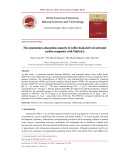
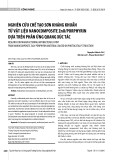
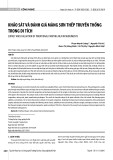
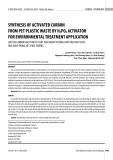
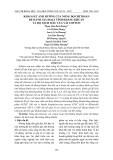

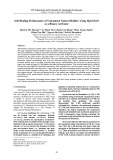
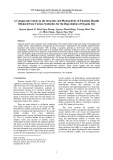


![Tài liệu Vi sinh vật môi trường [Mới nhất]](https://cdn.tailieu.vn/images/document/thumbnail/2025/20251123/ngkimxuyen/135x160/21891763953413.jpg)
![Sổ tay truyền thông Phân loại chất thải rắn sinh hoạt trên địa bàn tỉnh Quảng Nam [Chuẩn nhất]](https://cdn.tailieu.vn/images/document/thumbnail/2025/20251114/kimphuong1001/135x160/1701763094001.jpg)


![Quản lý chất thải nguy hại: Sổ tay Môi trường [Chuẩn nhất]](https://cdn.tailieu.vn/images/document/thumbnail/2025/20251029/kimphuong1001/135x160/9011761720170.jpg)









